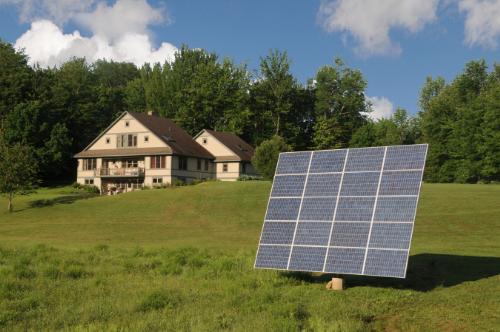If you’re interested in residential solar energy systems, but find that your roof isn’t suitable for a solar array, ground-mounted solar systems are a viable alternative.
In the past, solar energy systems installed on the ground were more expensive than rooftop arrays. The additional mounting equipment spiked installation costs.
Now, however, a solar tracking device is starting to offset that added expense.

GPS technology has found its way into residential solar panel systems. GPS monitors the exact latitude and longitude of the system, as well as the precise time of day and date.
The technology triggers a motor to tilt the solar panel up and down and from east to west, catching every available ray of sunlight. This significantly increases the overall efficiency of the system. For the consumer, this means more bang for the buck.
Vermont-based AllEarth Renewables is reporting that their GPS AllSun Trackers boost solar energy production by up to 45% compared to fixed ground-mounted systems.
In Vermont, a single 4.2-kilowatt AllSun Tracker solar energy system will produce an average of 490 kilowatt hours each month, more than half of an average home’s electrical needs.
AllEarth is partnering with ReVision to begin installing the dual-axis ground-mounted systems throughout Northern New England. AllEarth has already installed over 800 solar trackers.
More energy production equals more electricity, and getting more electricity from a solar system significantly changes the formulas used to calculate how soon homeowners can expect a return on their investment.
Solar energy system installation costs are recouped through savings on monthly utility bills over a period of time. Purchasing a ground-mounted solar system with a GPS tracker over a fixed system will most likely result in substantial savings.
Comparing costs between a GPS tracker ground system and a rooftop solar array is a bit more difficult. Ground-mounted systems not only require additional equipment, they usually involve digging a trench to connect wiring to the home. On the other hand, ground systems go up much more quickly, usually in one day, which cuts down on labor costs.
GPS tracker systems are available from numerous solar contractors throughout the United States.
Most residential ground systems are mounted in a fixed position, as are most rooftop solar systems. Ground systems that tilt as the sun passes over the sky have primarily been the domain of solar power farms, covering acres of barren land in rows and columns of individually mounted systems, all set on timers to follow the sun.
Determining the optimal system depends on several factors, including the home’s electrical needs, the stability of the roof, the roof’s orientation to the sun and whether or not there is adequate space for a ground-mounted system.
An inspection from a professional solar contractor can establish the best — and the most economical — way to go solar.
 Follow
Follow